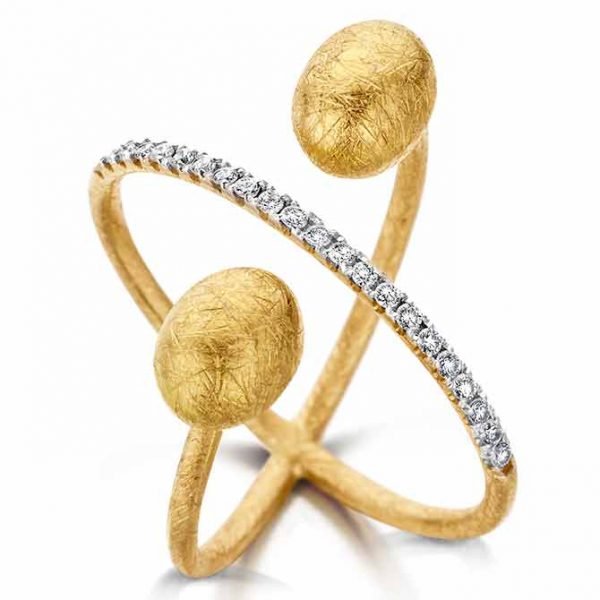
SEO, social media marketing, and trends such as yellow gold and colored stones will dominate the retail jewelry landscape. And don’t forget about those all-powerful millennials!
As the jewelry industry looks ahead to 2018, there are plenty of changes on the horizon. Owners, executives, and experts express optimism even as they contend with disruptions ranging from technology to trends. Here are the new ideas and top priorities they’re embracing for the coming year.
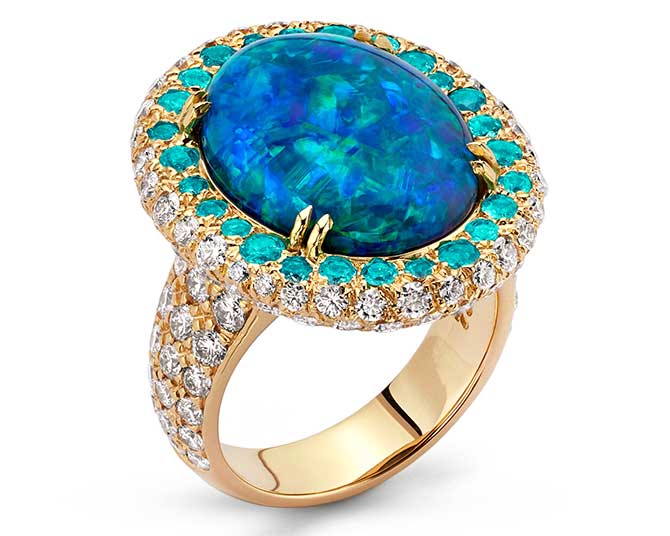
9.93 ct. Lightning Ridge black opal ring with 0.74 ct. t.w. paraiba tourmaline and 3.45 cts. t.w. diamonds in 18k gold; $62,000; Pamela Huizenga; 772-871-0033; pamelahuizenga.com
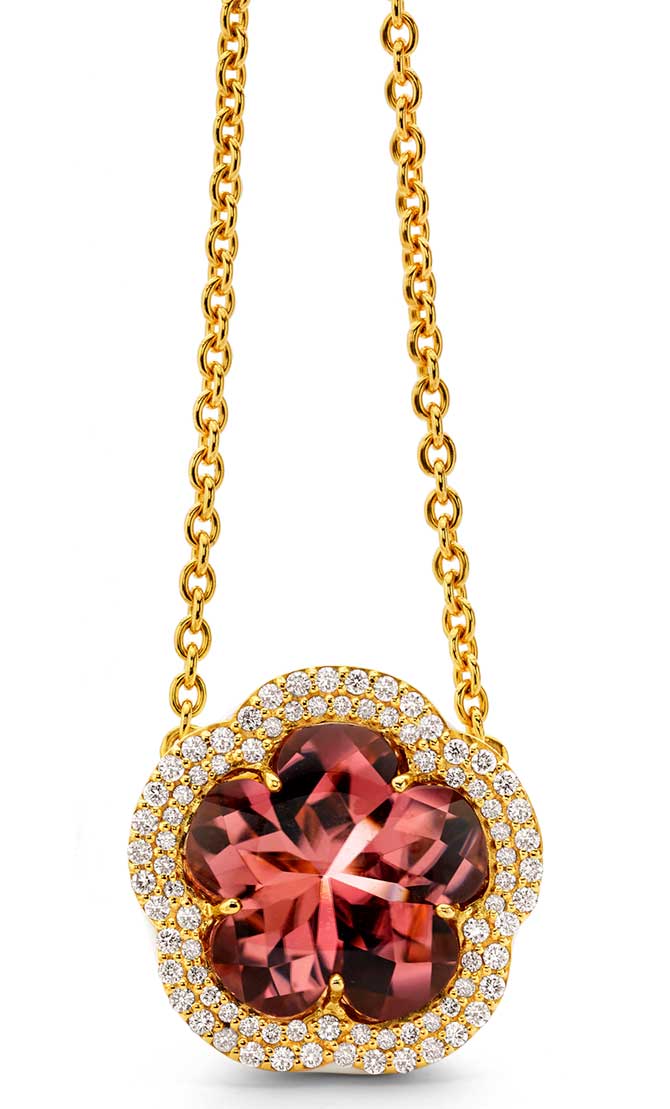
11.65 ct. rose tourmaline flower necklace in 22k gold with white enamel and 0.73 ct. t.w. diamonds; $13,100; Buddha Mama; 305-439-2059; buddhamama.com
Marketing Dominated by Social and Search
The digital domain is increasingly important for reaching customers and delivering messaging that will resonate with shoppers. That begins with establishing a web presence, but merely having a website is not enough.
“We worked hard on improving the functionality of our site because we believe a client wants to engage on your website in a manner that’s convenient,” says Lane Schiffman, co-owner of Schiffman’s, headquartered in Greensboro, N.C., with 11 stores in four states. “We’re producing blogs and content that are genuinely interesting to our clientele.”
Increasingly, investing in an online presence means getting a handle on search engine optimization, aka SEO, according to Shane O’Neill, vice president at Fruchtman Marketing in Toledo, Ohio.
“One of the things that’s old but now new is SEO,” he says, adding that search is growing in importance because more customers do online research prior to shopping, and many use their mobile devices to find physical stores near them. “Fifty-plus percent of traffic is coming from mobile devices to websites, and that’s all led by search. And now you’ve got much more competition at local levels.”
Social media advertising helps jewelers cut through the clutter because these platforms give brands the tools to target the most receptive consumers, says Jeff Corey, co-owner and vice president of marketing at Day’s Jewelers, which is headquartered in Waterville, Maine, and has seven stores across Maine and New Hampshire. “The opportunities today with social networks are tremendous,” he adds. “You can deliver multiple messages to multiple demographics.”
Many jewelers turn to the trinity of social channels—Pinterest, Facebook, and Instagram—to stimulate demand. “That’s the only way to create that desire,” says Lynn McCary Thomas, co-owner and president at McCary’s Jewelers in Shreveport, La.
But there’s much more to digital advertising than social media. “We’re also working with influencers,” says Scott Berg, president of Lee Michaels Fine Jewelry, with stores in Louisiana, Mississippi, and Texas, of the social-media marketing technique. “We have a network of people and make sure they’re out there promoting our jewelry.”
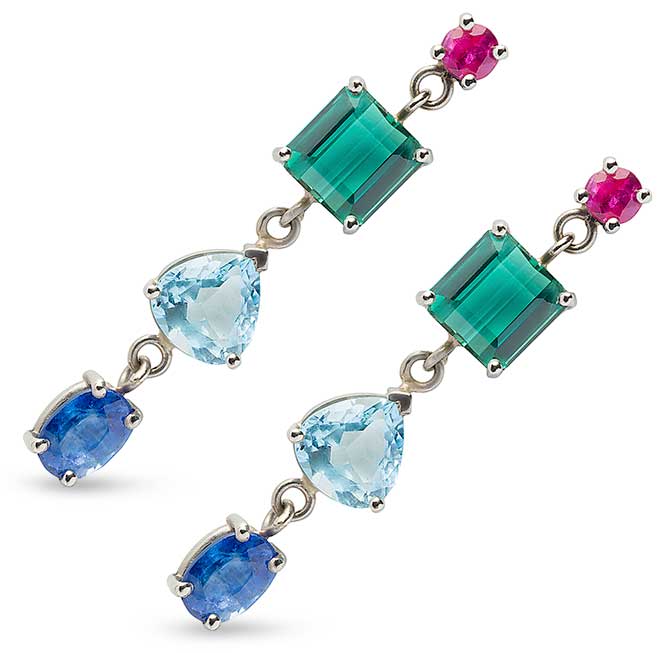
Liz collection handmade white gold earrings with ruby, tourmaline, aquamarine, and sapphire; $9,800; Nana Fink; contact@nanafink.com; nanafink.com
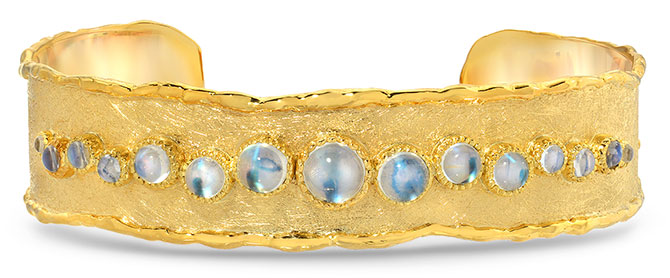
18k gold cuff with 4.4 cts. t.w. moonstones; $15,000; Victor Velyan; 213-955-5950; victorvelyan.com
E-Commerce as a Driver for In-Store Sales
Although e-commerce has been around for decades, jewelry retailers have been slow to adopt the practice. Now, however, more are realizing that having an online sales platform can be beneficial—as much for its role in facilitating in-person sales as for selling online.
“The actual transactional revenue is not the critical aspect of the online segment; it’s the influence on upcoming purchasing decisions that really impacts,” says Harold Dupuy, vice president of strategic analysis at Lafayette, La.–based Stuller Inc. “Online has a direct impact on consumers’ buying decisions.”
The big question: How can jewelers track the customers who come into their store after spending time on their site?
Sophisticated technology capable of performing this kind of tracking does exist, says jewelry website and marketing expert Matthew Perosi, but the cost and complexity can make it unattainable for smaller stores. So savvy retailers are finding new ways to quantify how an investment in their digital footprint will pay off.
“We need to have more product that’s available online and tell people where they can find it, because we really see it as a tool that enables shopping,” says Marc Bridge, vice president of marketing at Seattle-based Ben Bridge Jeweler. “For a long time, we optimized against direct sales—either they bought something or they didn’t,” Bridge says. “Now we’re optimizing against other metrics like a find-in-store lookup. We’ve invested in that as a success metric.”
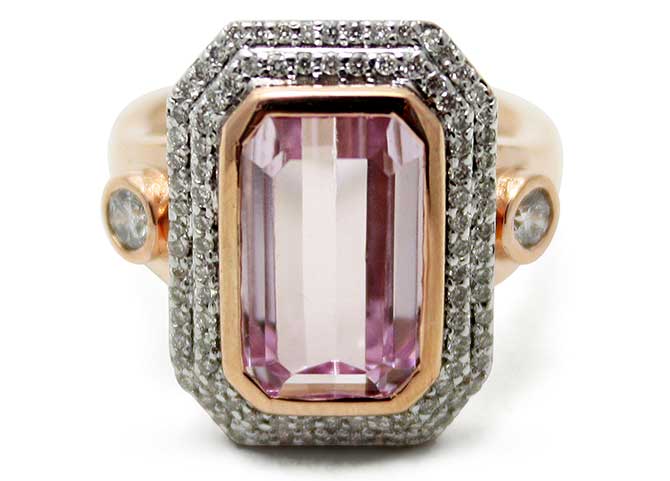
Dream collection 18k rose gold ring with 6.2 ct. Brazilian kunzite and 0.75 ct. t.w. diamonds; $2,980; Mia Katrin for Jewel Couture LLC; 336-329-9341; jeweljewel.com
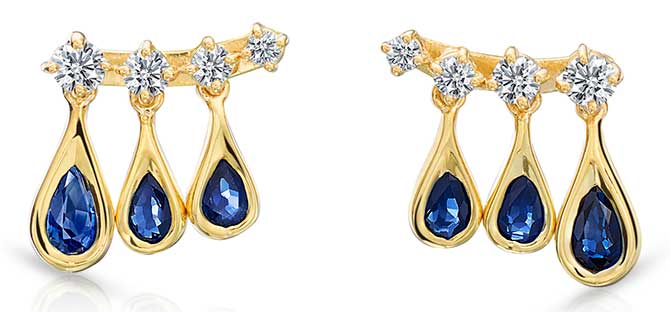
Drop earrings in 18k yellow gold with 1.99 cts. t.w. sapphire and 0.39 ct. t.w. diamonds; $4,685; Maria Canale; info@mariacanale.com; mariacanale.com
Stores Embracing Engaging Experiences
Getting shoppers into stores is a perennial challenge for retailers. These days, jewelers are finding inventive ways to usher a new generation of customers through the door of a brick-and-mortar store after bringing them to the retailer’s “virtual doorstep.”
“Obviously, the internet is a disruptor, but I think what it does is raise the question, How do we offer an experience that can’t be replicated on the internet?” Berg says. “We’ve had to make sure that every customer who walks through our door has an extraordinary experience.”
Thomas echoes that sentiment, saying that a recent renovation was designed to make McCary’s Jewelers more approachable, with the showroom decked out in white tones; sleek, flush cases; and private rooms for personal consultations. The effect, she says, is similar to that of an Apple store, where products are front and center and customers are encouraged to browse and linger.
Corey says Day’s Jewelers has put out pets’ water bowls and tennis balls printed with the brand’s logo so customers feel comfortable bringing in their four-legged friends. “We remove the intimidation factor,” he says. Encouraging customers to post photos of their cute pooches with the store’s logo in close proximity is an added bonus.
Another critical component of making customers feel comfortable is hiring sales associates who project a welcoming mix of friendliness and expertise.
“A trend that we’re seeing and that will likely move forward over the next five years is investment in employees that really know what they’re doing,” says Anya Cohen, an analyst at research firm IBISWorld. “Having a knowledgeable employee base is increasingly important,” she adds, since store shoppers expect the person behind the counter to know even more than they were able to learn from online resources.
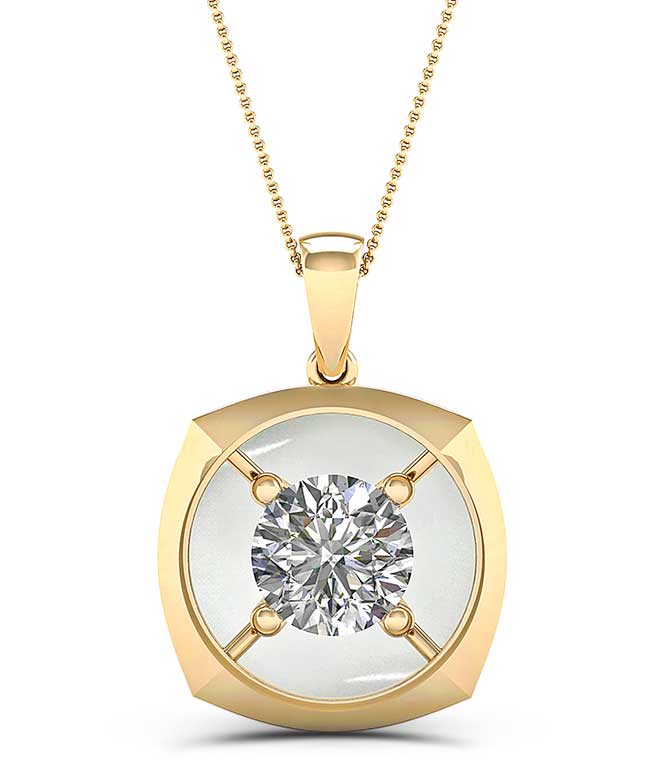
Pendant in 14k yellow gold with 0.25 ct. diamond; $599; Magnificence; info@magnifyyourlove.co; magnifyyourlove.co
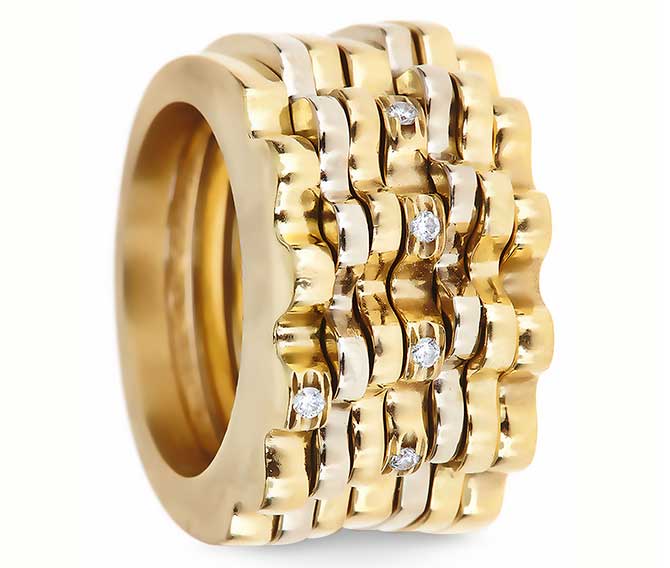
Ella stack rings in 18k gold, $680, with one diamond, $800, with four diamonds, $1,120; Ilana Ariel; sales@ilanaarielcollections.com; ilanaarielcollections.com
Shoppers Who Crave Color and Value Variety
When jewelers describe product trends they expect to be strong through 2018, an overarching theme is the industry’s greater focus on the needs and preferences of millennials, aka Generation Y, shoppers who were born in the 1980s and ’90s.
“Millennials don’t want their mother’s jewelry,” says Rick Moore, store director at Bellusso Jewelers in Las Vegas.
Stackables are hot with this group of consumers, according to Blaire Hovis, a fine-jewelry product manager at Stuller. “We’re still seeing a strong trend in stacking and layering, not just with rings, but bangles and cuffs and…necklaces.”
This is appealing to retailers as well as their customers, because the price point to entry is often less than for a single, larger piece. And the nature of the trend encourages multiple purchases and an eclectic variety.
“The trendy stuff can be mixed and matched all day long,” says Thomas, adding that the stackable trend is practically a staple in the bridal space, with women layering multiple bands—such as eternity bands and bands commemorating the birth of children—along with the traditional engagement ring and wedding band.
Customers are seeking out unconventional gemstones, from moonstone and morganite to tsavorite and tourmaline, in a quest to achieve a unique look—a key priority of the millennial shopper, many jewelers say.
“Colored gemstones give us a great opportunity to attract younger females to our store because they’re less traditional,” Corey says. “They’re unique—there’s an intrigue, a story behind them.”
Adds Thomas: “You show a young person a long rectangular tourmaline, they think that’s the greatest. And they love opals—those really are having a moment.”
Lindsay Daunell, co-owner and president at D&H Jewelers in San Francisco, says more customers today want to add color to engagement rings, with blue, blue-green, and yellow sapphires in cuts like squares, Asschers, and ovals growing in popularity.
Shoppers also are gravitating toward yellow gold, retailers say. After years of being relegated to also-ran status, yellow gold has burnished its image in fashion jewelry.
Some of these alternatives are driven by pricing pressure, as retailers look for ways to dazzle and delight a generation that has not yet adopted their parents’ spending habits. Even top luxury brands are experimenting with ways to woo these younger shoppers, notes Bellusso Jewelers’ Moore. Earlier this year, for example, Cartier reintroduced its iconic Panthère watch in stainless steel.
“We’re competing with an experience,” says Moore, who believes the industry has a duty to educate millennials about the intrinsic and sentimental worth of fine jewelry. “We’re trying to give people a greater value.”
(Top) Dancing in the Rain ring in 18k yellow gold with diamonds; $1,401; Nanis; america@nanis.it; nanis.it